May every one of you have lots of great tea this coming year!
Entries from December 2007
Happy New Year!
December 31, 2007 · Leave a Comment
Categories: Old Xanga posts
Tagged: administration
An oldish oolong
December 30, 2007 · Leave a Comment
One of the joys of drinking these older oolongs that I’ve been drinking is the freedom from any sort of label, hype, or influence from others, really. When a tea that I buy has no label at all, or at best a suggestive “this is an old baozhong” to go by, I can drink and appreciate the tea on its own merit, rather than thinking about what reputation it stands up to, whether it’s really worth the exorbitant price, etc, that are often thought processes that go through one’s mind when drinking an older puerh. For me, at least, it reminds me of the simple pleasures of simply enjoying a cup of tea and not worry about the things that really don’t have a lot to do with the tea itself.
The easy going prices of most of these teas also allow me to experiment and sample in a way that isn’t possible with older puerhs. Today I drank a tea that I picked up on the way to the candy store one weekend. It’s an oldish baozhong that looks a little odd
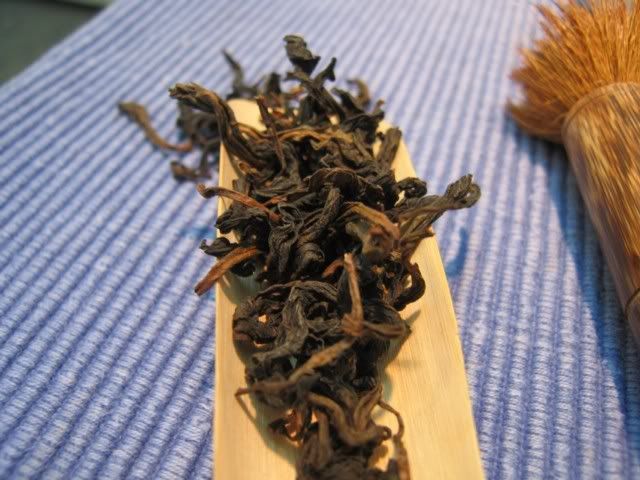
It might not be obvious in this photo, but the leaves are an orangy-green colour, and the stems are exceedingly long and obvious. I didn’t get to try it when I bought it, and so I only got a small amount. I was guessing it’s about maybe 10-15 years old or so, unroasted since it was first processed, and therefore quite rare in that sense. I figured a little of this, if it turns out to be a decent tea, will help me get a fuller picture of what an old, not so old, and youngish baozhong taste like in their various stages of aging.
When I opened the bag today I smelled a whiff of sourness, which worried me. I remember smelling it at the store too, which was one reason why I didn’t buy too much of it — I didn’t know how the sourness would manifest itself in the cup. Then things got hectic and I didn’t even get a chance to try this tea out before I left Taiwan. Now’s my chance to redeem myself.
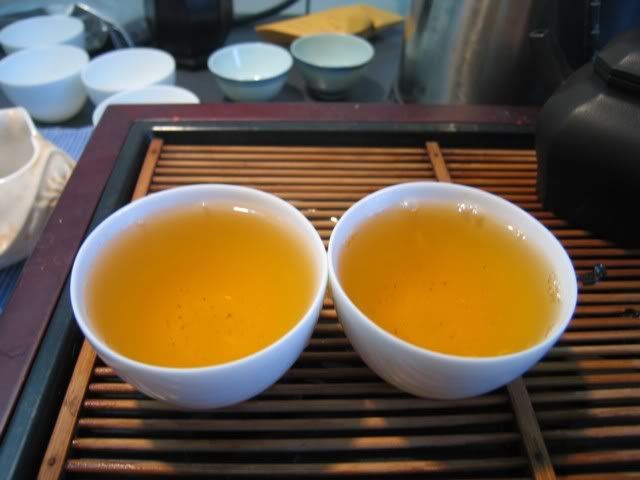
The colour of the tea is a pleasant orange, just like the leaves. I didn’t use much leaves since I worried about sourness, but it turned out to be not a problem at all – there was not even a hint of sourness in the tea itself, which I found strange, given the smell. Mind you, maybe my black pot helped, I don’t know. Since I probably will use the black pot from now on to brew this tea, it probably doesn’t matter…
It is an interesting tea, tasting more honey like than anything else, and has a hint of that aged taste that I am now quite familiar with in older baozhongs. It hasn’t quite turned fruity yet though, and retains a bit of that young baozhong aroma. What is interesting about this tea is that it is very minty down the throat — I could feel it going down, as if I had just swallowed a mint. It was really obvious for two cups before that effect died down. Interesting.
There was also no hint of bitterness to be detected, no matter how hard I tried to overbrew the tea. I think next time, I ought to use a little more leaves, but at the moment, I’m wondering why I didn’t pick up more of this tea.
The wet leaves are also an interesting bunch — note the size of the leaves. They are certainly above average in size, with the stems being a prominent feature. Haven’t really had a baozhong that looked like this. Then again, provenance doesn’t really matter as long as the tea stands up, and this one certainly does.

Categories: Old Xanga posts
Tagged: aged oolong
Fenghuang Shuixian
December 29, 2007 · Leave a Comment
I think there’s a law for tea bloggers — samples will always come in faster than you can finish them. I have been away for a long time, and so have lots of these unfinished samples that I ought to go through. Today’s is one such sample.

The bag is characteristic of one of the members of the SF drinkers. I suspect this is from Psychopuncture… it says “Fenghuang shuixian — from Jing” on the bag. I don’t see a Fenghuang shuixian on their website, but seeing that this sample is at least a year old, I’m not too surprised if they ran out of stock.
The leaves are long, big, and sturdy. It’s hard to tell from the picture, but they are actually of a greenish hue. Seeing that, I didn’t put in that much leaves, figuring it might be a bit on the light side. I was right.
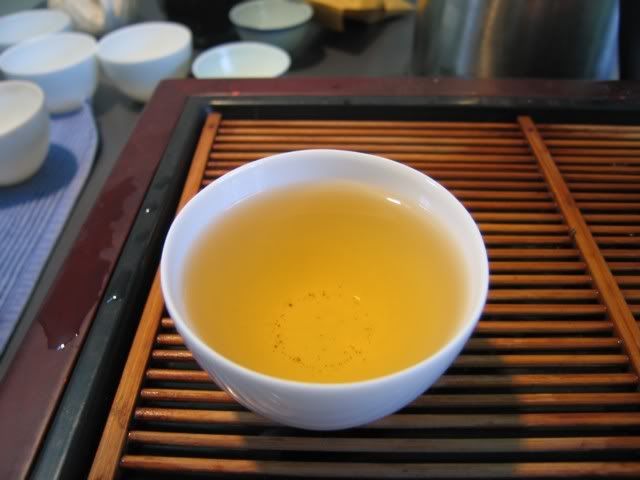
It has a honey-like aroma and taste, and a lot of “tea” taste underlying it all. It’s got a clear Phoenix Mountain tea sort of flavour profile and really doesn’t share a ton of similarity with shuixians from the Wuyi region. Processing obviously has something to do with it, as Wuyi stuff tend to be heavier fired/oxidized, and I think on the whole, I prefer teas from Wuyi than from Phoenix Mountain. The light processing keeps a healthy dose of bitter in the tea, and I personally am no big fan of that…. despite the high fragrance.
You can see just how green the leaves are

The tea is not bad, it’s just not my cup. I do wonder why it is that I decided I no longer like this sort of thing. I remember I used to really love teas like this.
Categories: Old Xanga posts
Tagged: Chinese oolong, dancong
Trying a different pot
December 29, 2007 · Leave a Comment
I used my other new pot yesterday to brew my tea and wanted to see if anything was different… it’s the same aged baozhong as the first tea I drank when I came back to the States
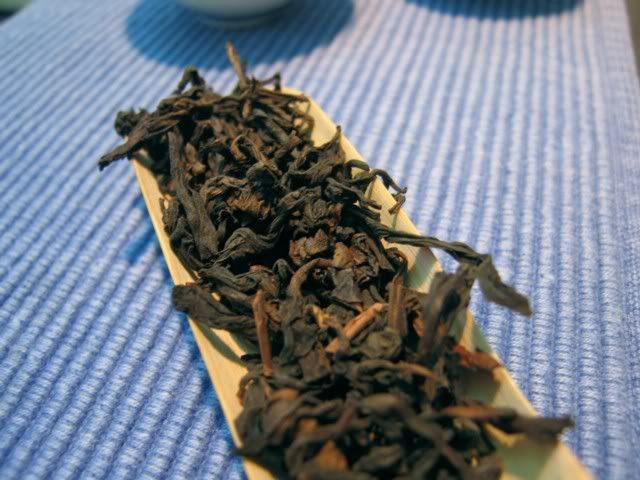
I somehow feel that when I had this tea yesterday, using the zhuni pot instead of the black one, the tea came out a little more sour. The black pot softened the sour a little, it seems, whereas the zhuni pot is a little more “honest” and gave me everything. This tea is a little sour when made in a gaiwan — as are most aged baozhongs of one kind or another. Somehow, if I am not fooling myself anyway, the black pot seems to more or less eliminate the sourness in this tea. The density of the material used to make the pot might have something to do with this.
This isn’t as good a tea as the competition oolong. It doesn’t quite have that level of aroma or flavour, but it does have its virtue, and turns quite sweet with a sort of raisin aroma at some point (although with my water here it really does taste rather darjeeling like sometimes). I guess I can’t complain when I’ve bought enough of it to make this an easy everyday aged oolong, and I am hoping that perhaps with some more aging, it will change for me from bag to bag as a sort of experiment in and of itself.
Categories: Objects · Old Xanga posts
Tagged: aged oolong, teaware, yixing
25 years old competition tea
December 28, 2007 · 3 Comments
I sat down yesterday to drink the competition tea that I got from the candy store right before I left. I only have a small bag of this stuff, so I suppose I shouldn’t drink it all too quickly, but it’s tempting.
This tea is supposedly around 25 years old, and entered some competition back then. I am not sure if it won anything, but it doesn’t really matter. What matters is that this tea is very well stored, and display no sourness or really anything that is undesirable.
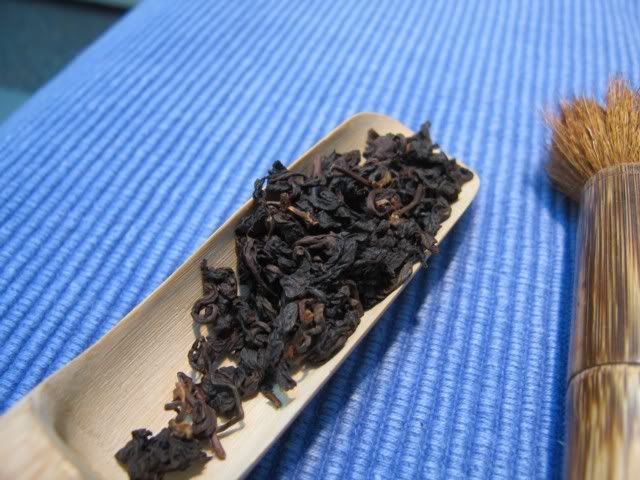
The colour of the tea is a pleasant orange. I think aged oolongs that have this sort of colour are generally of the unroasted (or rather, un-reroated) kind. The ones that develop a darker colour often have been reroasted at some point. That’s not to say they’re bad, just different. For teas that haven’t been re-roasted, I find that they develop a fruity perfume, and tend to die a little faster than the reroasted teas.
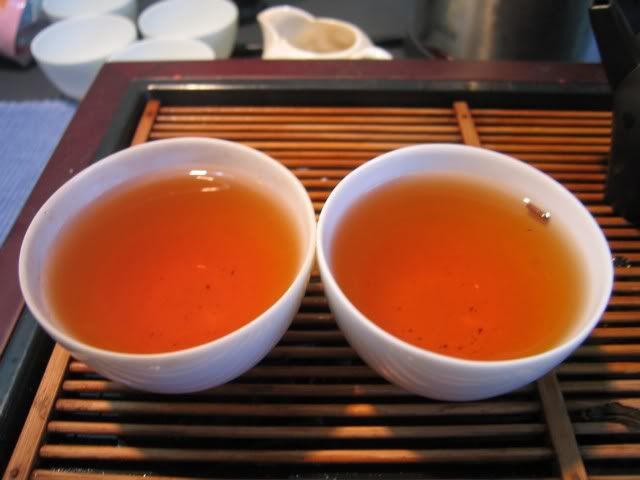
This competition tea is the same — it starts out with an intense peachy aroma, gradually giving way to a more “tea” like flavour, but never really gaining any sort of bitterness or roughness. It’s smooth and sweet. What I like about it is the good qi that comes from it — an obvious sense of energy that only really show up with better teas. Different teas have different ways of displaying their qi. There are those that knock you over the head, and those that only slowly makes you feel warm and fuzzy. Not surprisingly, I like the latter kind.
The tea gets more subdued after 5-6 infusions but lasts quite a while. I’ve been using my new black pot to brew, and I find that even teas that had a little sourness in them no longer display that quality. The aroma also has gained a little more focus, for some reason. I’ve also used relatively less leaves than I would with a gaiwan.
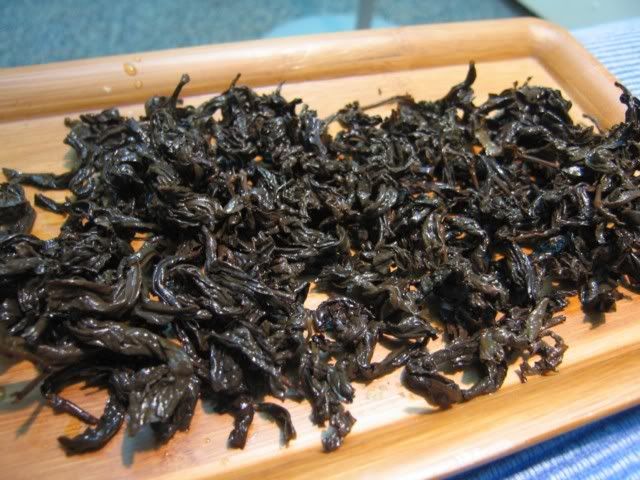
I need to keep experimenting with my new pots…. I think today I’ll try the zhuni one to compare how they do for aged oolongs.
Categories: Old Xanga posts
Tagged: aged oolong
Changing environment
December 26, 2007 · Leave a Comment
Nothing reminds me of the importance of other objective factors in tasting a tea than a completely changed environment. Slightly recharged with the first quality sleep in two days, I brewed some of my aged baozhong this morning. I used my new pot, local water, and bam…. the tea is very different!
I think the first few infusions resembled a good darjeeling, without the bitterness or the roughness. Anybody who didn’t know it’s an aged baozhong would’ve guessed it is darjeeling. I don’t know if it’s the water, the pot, or a combination thereof, but I never got this darjeeling sense when I had this tea in Taiwan.
Then, a little later, the tea turned into something more fruity. This part I’ve gotten in Taiwan, but not in the same way. The tea seems smoother. I think that might have to do with the pot. I can perhaps try doing this tea with a gaiwan and a pot…. but I don’t think I need to, because I’ll be making these things with my new pot anyway.
Categories: Old Xanga posts
Tagged: musings, skills
Delirious thoughts
December 26, 2007 · 4 Comments
I typed this as I was sitting in ORD, drinking a cup of McDonald’s tea and awfully sleep-deprived. I started thinking about my tea adventures for the past year and half in China and Taiwan. When I started on my trip (the pirmary purpose, I should note, is not for tea) I think I knew very little. This blog started about half a year before I left for Beijing, and reading back to some of the very earliest entries, I can see that I had a very murky idea of what made a good tea. While I was not totally limited by access as many readers of this blog probably are, considering that I could buy all sorts of things from Hong Kong or even China, it was a lack of experience, knowledge, and confidence that hampered me.
Experience is easy to see, but hard to solve. No amount of reading or hearing about other people’s experience will make up for drinking the teas oneself. I can rant and rave about the sweetness of the Yiwu cake that I bought, or the complexity of the old oolongs I found in Taipei, or the stunning freshness of a top notch mingqian longjing, but until you’ve actually tried all those things in person, and also having had the opportunity to compare it to other Yiwus, oolongs, or longjings, it is difficult to truly get what it is that makes those teas great.
This is unfortunately where the problem of access to good teas becomes particularly acute. Most of the teas available to Western drinkers are rather limited in scope. Chinese teas (which is mostly what we talk about) are particularly problematic in that most of them have no branding or labeling. Anybody can buy a low grade longjing and tell you it’s top grade mingqian longjing. If you’ve never tried a true top grade mingqian longjing from somebody that is absolutely trustworthy, then how would you know what that is like?
Puerh is even more of a problem, despite the fact that they are actually branded and labeled. Here, the issue is that most of the cakes on sale through internet or real life vendors are mass-consumption, market oriented teas. Most of them are plantation tea (even if they have “wild old tree” emblazoned on the wrapper). The few vendors that do offer what seems to be higher grade puerh are usually sourcing it from the same one or two people. That in itself is a problem, because if you’ve had a few weeks of drinking through any one of the bigger Chinese tea markets, you’d know that the puerh world is very diverse. For a good that is purchased with a view to age, betting all your chips on one or two producers is actually an extremely risky move. At the very least, it might mean that 20 years down the road, the stash of tea might all share many of the same characteristics, because they are processed similarly. That’s fine if you like it, but if it doesn’t turn out to be to your liking… then we have a problem. When most experts can’t really agree on exactly what will make a good aged cake, that means that any one of the experts’ view could potentially be wrong.
Knowledge obviously includes experience, but it also encompasses things like objective facts that one can learn through books, the web, teachers, etc. Not all of these knowledge that can be easily acquired are necessarily true either. As Jason pointed out in his first article in the Art of Tea magazine, much of this information is conveyed to the Western drinker via vendors of tea. As you can imagine, they have an inherent conflict of interest when telling their customers things about the teas they’re selling. I’ve met literally hundreds of vendors by now, and I can say that not a single one of them have ever said a truly negative thing about their own tea that they’re trying to sell. Of course, one’s hope is that the vendor truly believes whatever that is being sold is a good tea, and oftentimes this is indeed the case. However, there are also those out there who will provide partial facts, use “vendor speak” (“interesting character” instead of “off taste”), and sometimes even deliberate misinformation just to push a tea. There are people whom I’ve originally regarded as a teacher, but whom subsequently I’ve discovered that they are merely somebody who wants to sell me tea. Understandable, of course, because they have to make a living out of it. But the moral of the story is, not everything told by a vendor is going to be true, and it’s best to compare sources.
Confidence is a byproduct of having some knowledge and experience. It takes confidence to know that a tea that you just bought is indeed good or bad (sometimes despite what people say). It also takes confidence in yourself to let the tea talk to you when brewing it, and make the necessary adjustments while making the tea, for example. But perhaps more importantly, it takes confidence to know that there’s always something that you don’t know, and that it’s ok to be wrong. I’ve definitely learned things from those who are complete tea novices, who don’t know an green from a black, but whose comments on teas I’ve made for them told me things that I didn’t think of, or didn’t know, or didn’t even consider. There’s a difference between opinion and fact. Everybody is of course entitled to their own opinion, but opinions, I think, can be wrong if based on incorrect assumptions or facts. I’m not a post-modern type, and I am so old fashioned that I think there is actually a truth somewhere out there (unreachable though it may be sometimes). When somebody thinks this young puerh has licorice notes in it, that’s an opinion that can’t be disputed. When somebody thinks this young puerh is old tree tea because the leaves are big, then… we’ve got a problem (young plantation tea can still have very big leaves/buds!). The first kind of opinions are things to which everybody can contribute. The second kind are errors that I see sometimes, and are things that I’ve committed from time to time. To the best of my ability, I try to rectify them as I learn about them. Drinking tea is humbling — there’s always somethings you don’t know.
Speaking of which, this McDonald’s teabag isn’t half bad. It has this keemun-eqsue sweetness in the back end that I generally associate with China blacks (maybe Kenyan or Argentinian or whatever blacks also do this? I don’t know). Since this is a blended tea, maybe there’s some Chinese teas in there. The slight sourness up front is a bit nasty, but… I’ve had worse.
And a belated Merry Christmas to everybody!
Categories: Old Xanga posts
Tagged: musings
Delayed
December 24, 2007 · 7 Comments
Lovely day to be delayed, Christmas Eve, and my flight from SFO to IAD has an air conditioning problem, jeopardizing my connection to CMH from IAD. Yay
Categories: Old Xanga posts
Tagged: travel
A parting meeting
December 23, 2007 · 2 Comments
I went to Wisteria today, to see Aaron and a couple who are making a documentary about tea. I met the couple once already, but since I figured Aaron might be able to help them a lot more (seeing as he’s in Taiwan and all) we planned to meet together before we left. After some discussion, the meeting ended up being at Wisteria.
We started with a tea that Aaron brought with him — some tea from Tibet. It’s a mixture, actually — a tea with some other plant. Aaron thinks it’s a white tea plus some moss-like herb. We really have no clue. It reminded me of the incense smell I get from flipping some of these old books that I regularly have to read, most likely because the books were stored in places where incense was burned regularly. It’s a very calming tea, actually, and the plant, whatever it is, has a sort of citrus like taste and a great aftertaste. I could feel the medicinal quality of this thing. Very very nice stuff.
Then we had a 1930s puerh called “Shuang Hua” or twin flowers. Not one of the most famous brands out there, but it’s still old nonetheless. It’s a relaxing tea — mellow, good soft qi, but not too powerful (there’s a reason it’s not that famous). Still, one can’t complain about drinking stuff like this.
It was a nice tea meeting to end my visit in Taiwan this time. They sometimes call Taiwan “Treasure Island” here. For the tea enthusiast, there’s a lot of treasures to be found, provided that you’ve got the time, energy, and patience to deal with it. It took me a while before I had a sort of breakthrough in finding good stuff, but I think eventually I found some pretty nice teas and teaware along the way. I’m sure I’ll come back, but for now… I am looking ahead at a 24 hours trip through SFO and IAD to CMH. I wonder if I’ll see snow tomorrow?
Categories: Old Xanga posts
Tagged: aged puerh, friends
More last minute shopping
December 22, 2007 · 9 Comments
I finally went back to the teapot store again today. It’s a bit of a pain to go there, because the place doesn’t really have regular hours. It’s more like an office in an obscure building with semi-functioning elevators, and I have to call ahead to book a time to go up.
I lingered for a while, and came home with these

It’s strange, because normally, I’m no fan of squarish teapots. Somehow though, both of these caught my eye — especially the black one.
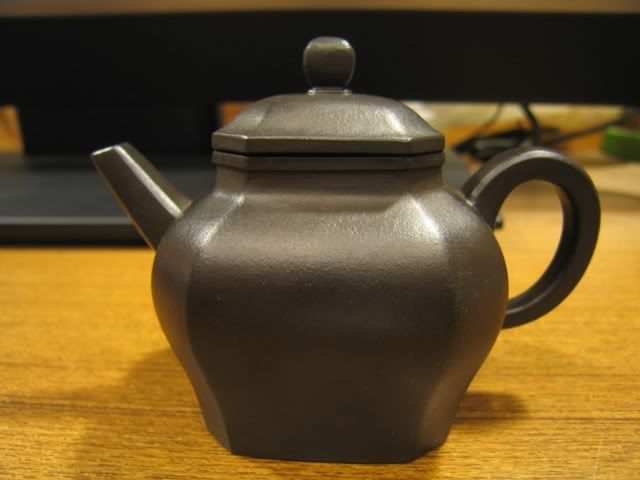
Which I discovered is actually dark dark brown
The other
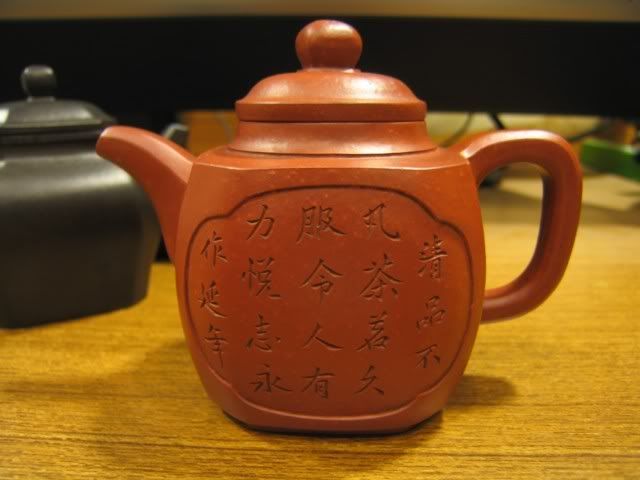
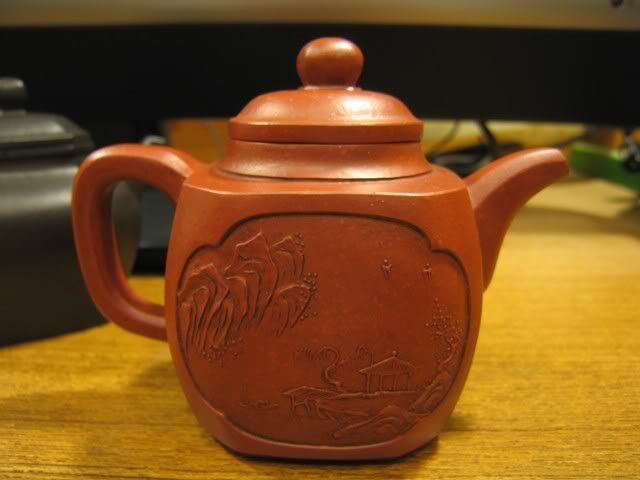
I thought looks almost like one of those pewter tea canisters.
While there, he brewed some truly nasty Taiwan (?) oolong. It’s somewhat roasted, but still has that grassy flavour. I did my best to pretend I was drinking it, but it really made me think that for many, good pots are an end in itself, and good tea…. is not important. For me, tea always takes precedence. Teaware only enhances the tea, and that’s their function.
I came home and made some of the competition tea that I picked up yesterday, although under sub-optimal condition since I don’t have my normal set of tools with me, having packed them and shipped them off on the slow boat. The tea is interesting — tastes a bit like an older version of the biyuzhu, without tasting like a puerh from the get go. It’s obviously a good tea — the qi is strong — but I need to make it again to confirm my thoughts on this one.
Categories: Objects · Old Xanga posts
Tagged: shopping, teaware, yixing

 RSS - Posts
RSS - Posts
I took you at your suggestion and have been reading some of your old post-Covid posts. I haven’t been to…